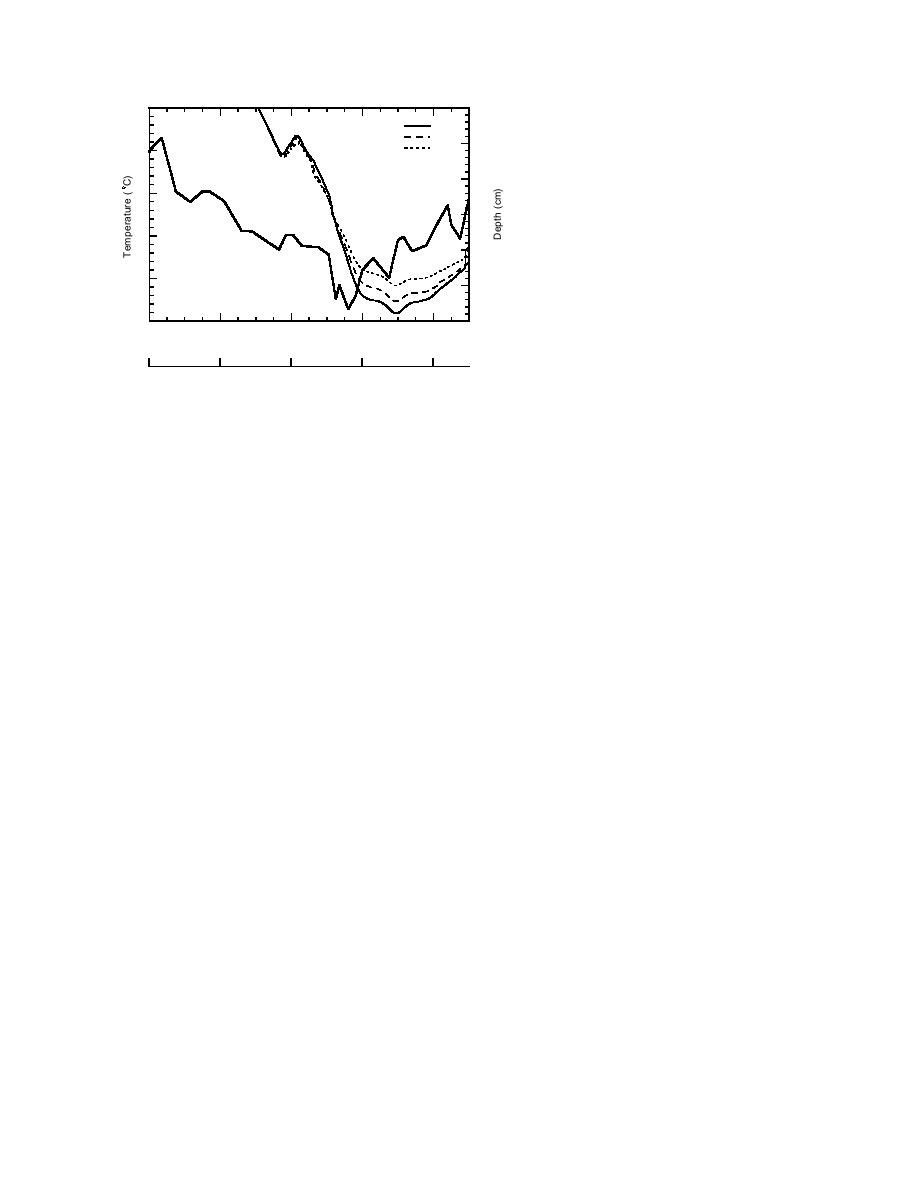
15
0
10%
17%
10
25%
10
20
5
30
0
40
Surface Temperature
-5
Figure 18. Location of the freezing front in silty
50
soil of 10, 17 or 25% moisture content, with a
sand inclusion present, as determined with one-
-10
60
0
40
80
120
160
dimensional numerical simulations under BC-
Day (22 Oct is day 1)
Cold conditions. The imposed temperature history
of the soil surface is also shown.
21 Oct
30 Nov
9 Jan
18 Feb
30 March
the remaining ∼50 days of the BC-Cold winter
from 44 to 17 to 15 days for BC-Warm condi-
(that period when the temperature of the soil
tions, and from 18 to 10 to 7 days for BC-Cold
surface is consistently less than 0C), the temper-
conditions (moisture content of 10, 17 or 24%, re-
ature difference is smaller, 0.2C or less.
spectively).
The small differences in temperature attribut-
Following this initial period, the soil at 37.5-
able to the presence of the sand inclusion would
cm depth is warmer under a sand inclusion. The
not be significant if the soil temperatures were
10% moisture content soil is warmer by a maxi-
greatly less than zero, on the order of 10C. If
mum of 0.04 or 0.16C under BC-Warm or BC-
the temperature of a silty soil that cold varied by
Cold conditions, respectively. In these cases the
even a few degrees, the unfrozen moisture con-
greatest depth of the freezing front differs only
slightly (∼1 cm) whether or not a sand inclusion
tent of the soil would not change appreciably
(Williams 1967, Anderson and Morgenstern
is present, and the freezing front does not even
1973). Under BC-Warm conditions, however, the
penetrate to 37.5 cm under BC-Warm condi-
lowest temperature that the soil at 7.5-cm depth
tions. For 17% moisture content soil, the maxi-
attained was ∼2.5C (Table 4). For silty soil un-
mum temperature difference is ∼0.2C under
BC-Warm conditions, but it is as much as 0.8C
der conditions that normally (i.e., when there is
no sand inclusion) would result in a tempera-
under BC-Cold conditions. There is a larger de-
ture of 0 to 2C for much of the winter, the de-
pendence of frost depth on the presence of a
crease in unfrozen moisture content associated
sand inclusion in this soil, with maximum frost
with a drop in temperature of several tenths of a
penetration being 67 cm less when the sand in-
degree may be large (Anderson and Morgen-
clusion is present; this is reflected in greater dis-
stern 1973). The decrease in unfrozen moisture
parity in soil temperature with depth. Finally,
content in turn causes a decrease in the electrical
for the wettest soil considered (25% moisture
conductivity of the frozen soil (e.g., Hoekstra
content), the maximum temperature difference
is ∼0.5C under BC-Warm conditions, and as
1969) that potentially improves electromagnetic
large as 1.17C under BC-Cold conditions. The
sensor system performance.
Although the soil types are different (silty soil
reduction in frost penetration because of the
in the simulations and sandy loam at SOROIDS),
presence of a sand inclusion is greatest, 711 cm,
field measurements agree with the temperature
or 1820%, for this soil.
relationships predicted by the simulations. Dur-
The heat flow simulations indicate that soil at
ing a BC-Warm type of winter (snow cover
a depth of 7.5 cm is generally colder above a
present), the SOROIDS soil with no sand inclu-
sand inclusion. For all moisture contents and
sion is infrequently colder than 3C at a depth
both BC-Warm and BC-Cold conditions, the
shallow soil is noticeably colder (0.3 to ∼1C)
of 7.5 cm. Half-hourly records of soil tempera-
ture indicate that the soil typically is colder dur-
during the period of rapid frost penetration in
ing only a few days of the freezing season. Com-
the sand inclusion. Following this, for the re-
maining ∼80 days of the BC-Warm winter and
parisons of soil temperatures at the sand inclu-
18



 Previous Page
Previous Page
